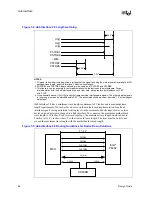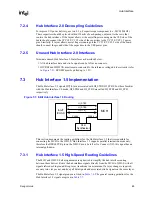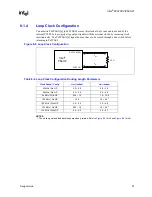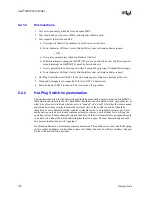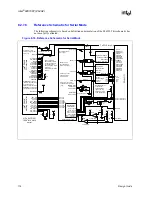
Intel
®
82870P2 (P64H2)
100
Design Guide
8.2.1.2
Hot-Insertions
1. User selects an empty, disabled slot and opens MRL.
2. User inserts add-in card, closes MRL, and attaches cables to card.
3. User requests that slot be enabled.
a. User requests that slot be enabled via a software user interface.
b. Power Indicator LED next to slot blinks while system software validates request.
-- OR --
a. User presses momentary Attention Button at that slot.
b. Software interprets change on HxPRSNT# pin as a push button event. (Software ignores
second interrupt on HxPRSNT# caused by button release.)
c. User is permitted to cancel request within 5 seconds by pressing Attention Button again.
d. Power Indicator LED next to slot blinks while system software validates request.
4. Hot Plug Controller asserts RST# to the slot; main supply voltages are present at the slot.
5. Clock and bus signals are connected to the slot; RST# is deasserted.
6. Power Indicator LED is turned on. The slot is ready for operation.
8.2.2
Hot Plug Switch Implementation
The mechanical design for the chassis should include a manually-operated retention latch (MRL)
that holds an add-in card in the slot. Each MRL should have an associated switch, optical device, or
other type of sensor to indicate whether a slot is “opened” or “closed.” (Note that the terms opened
and closed do not necessarily indicate the electrical state of the switches used, but should be
thought of as a mechanical door that enables or disables cards to be installed or removed.) A slot
can be auto-powered down should someone attempt to remove a card without first notifying the
operating system. The mechanical design should be such that it is impossible for an expansion card
to be removed without the switch indicating that the slot is open. The mechanical design should
also prevent inadvertent switch “openings.”
An Attention Button is a momentary-contact push-button. This button serves to invoke the hot-plug
service so that an adapter can be added or removed without the use of a software interface. Support
for the Attention Button is optional.
Содержание Xeon
Страница 24: ...Introduction 24 Design Guide This page is intentionally left blank ...
Страница 30: ...Component Quadrant Layout 30 Design Guide This page is intentionally left blank ...
Страница 34: ...Platform Stack Up and Component Placement Overview 34 Design Guide This page is intentionally left blank ...
Страница 52: ...Platform Clock Routing Guidelines 52 Design Guide This page is intentionally left blank ...
Страница 66: ...System Bus Routing Guidelines 66 Design Guide This page is intentionally left blank ...
Страница 118: ...Intel 82870P2 P64H2 118 Design Guide This page is intentionally left blank ...
Страница 146: ...I O Controller Hub 146 Design Guide This page is intentionally left blank ...
Страница 148: ...Debug Port 148 Design Guide This page is intentionally left blank ...
Страница 210: ...Schematic Checklist 210 Design Guide This page is intentionally left blank ...
Страница 220: ...Layout Checklist 220 Design Guide This page is intentionally left blank ...
Страница 222: ...Schematics 222 Design Guide This page is intentionally left blank ...

